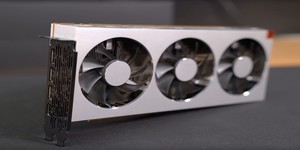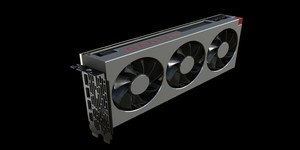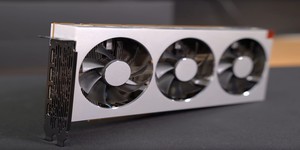
AMD has used its CES 2019 keynote to unveil a new flagship gaming GPU called the AMD Radeon VII, built on a 7nm process and using its second-generation Vega architecture, and it will be launching on February 7th 2019 for $699 (roughly £660 when converted with 20 percent added for tax).
Replacing the Radeon Vega 64 at the very top of AMD’s gaming GPU stack, the Radeon VII will offer twice the memory of its predecessor with a whopping 16GB of HBM2 (High Bandwidth Memory 2). With a 4,096-bit memory interface and a memory clock speed of 1GHz, the card will also come with a staggering 1TB/s of raw memory bandwidth available, which is more than double Vega 64 which sits at 484GB/s. It will be fabricated on TSMC’s 7nm FinFET process and uses a slightly gimped version of the Vega 20 GPU, offering 60 Compute Units and a total of 3,840 stream processors running at ‘up to 1.8GHz’. Based on those specifications, it is very clearly a Radeon Instinct MI50 revamped into a gaming-focussed SKU. No equivalent gaming version of the Radeon Instinct MI60 (which is fully enabled with 64 CUs and 4,096 stream processors) has been announced.
In terms of performance, AMD claims the Radeon VII will offer 29 percent additional performance in games on average, with 60fps 4K gameplay listed as a plausible use case. Our latest game benchmark results suggest that the Radeon VII will come in slightly below the Nvidia RTX 2080, as on average that offers a little over 30 percent more performance than the Vega 64. This also tallies with the pricing AMD has set of the card: $699, which targets the very lowest RTX 2080 pricing around and undercuts the majority of SKUs on the market. That said, AMD did show some slides showing performance that was equivalent to the RTX 2080 and even greater than it in an unspecified Vulkan title.
As you would expect, the Radeon VII will offer full FreeSync 2 HDR support, with AMD proudly pointing to its ever-growing FreeSync ecosystem and a total monitor count that now exceeds 550.
Physically, the card shown onstage was a large triple-fan model which looks set to be the AMD reference unit. As usual, board partners are also expected to offer a variety of alternative SKUs.
While exact performance of course remains to be seen, it’s interesting that AMD is basing its gaming-focussed version of Vega 20 on the cut down variant of the GPU, as the additional cores on a fully enabled version could have enabled RTX 2080-beating performance – going by AMD’s own figures and our own rough calculations, at least. It’s possible AMD is holding a fully enabled version in reserve, but equally AMD may not be getting enough yield from fully enabled parts to justify diverting them to the lower-margin gaming market. It’s also hard to know what such a part would be called given that Radeon VII is a clear reference to the 7nm process. Radeon VII.5? Radeon VII+?
While AMD has no current hardware-based answer to Nvidia’s DLSS or real-time ray tracing techniques enabled by the Turing architecture, AMD did wheel out a developer from Tom Clancy’s The Division 2 to point out that it will support advanced features found in Vega like shader intrinsics, rapid packed math, and asynchronous compute.
At launch, the Radeon Vega VII and systems that use it will qualify for AMD’s ‘Raise the Game’ game bundle, which includes free copies of Resident Evil 2, Devil May Cry 5, and The Division 2.
The AMD Radeon VII GPU is expected to start shipping on February 7th 2019 with a recommend retail price of $699 excluding taxes, which is roughly £660 including 20 percent tax when converted directly. More information is available on the official website.

MSI MPG Velox 100R Chassis Review
October 14 2021 | 15:04








Want to comment? Please log in.